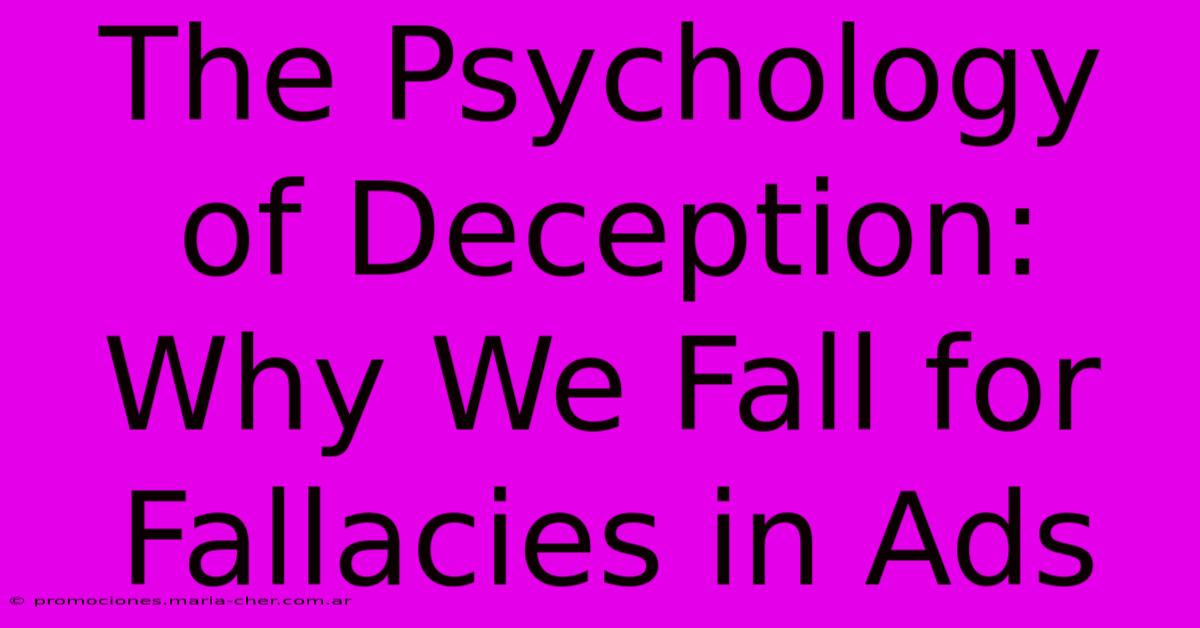The Psychology Of Deception: Why We Fall For Fallacies In Ads

Table of Contents
The Psychology of Deception: Why We Fall for Fallacies in Ads
Advertising is a powerful force, shaping our desires and influencing our purchasing decisions. But how much of what we see is genuine, and how much is cleverly crafted deception? Understanding the psychology behind deceptive advertising is crucial to becoming a more discerning consumer. This article delves into the cognitive biases and psychological principles that advertisers exploit to make their products irresistible, even when those products don't necessarily meet our needs.
The Power of Persuasion: Exploiting Cognitive Biases
Our brains are not perfect rational machines. We rely on mental shortcuts, or cognitive biases, to navigate the complexities of the world. Advertisers skillfully leverage these biases to influence our behavior, often without us even realizing it.
1. Anchoring Bias:
This bias refers to our tendency to rely heavily on the first piece of information we receive (the "anchor") when making decisions. Advertisers often use this by presenting a high initial price, then offering a seemingly discounted "sale" price. This makes the discounted price seem like a bargain, even if it's still higher than the product's actual value. Example: A luxury watch initially priced at $5000, then "discounted" to $2500. The $2500 price is anchored to the initial $5000, making it appear more attractive.
2. Availability Heuristic:
This bias makes us overestimate the likelihood of events that are easily recalled, often due to their vividness or recent occurrence. Advertisers use emotionally charged imagery and memorable slogans to create easily recalled associations with their brands. Example: A car commercial showcasing a dramatic rescue scene using their vehicle, making it seem safer and more reliable than competitors, even if statistically that's not necessarily true.
3. Bandwagon Effect:
This refers to our tendency to adopt beliefs and behaviors that are popular. Advertisers exploit this by emphasizing popularity, using testimonials, and showcasing large numbers of satisfied customers. Example: "Millions of people use our product!" This simple claim taps into our desire to conform and belong.
4. Confirmation Bias:
We tend to seek out information that confirms our pre-existing beliefs and ignore information that contradicts them. Advertisers capitalize on this by tailoring their messages to appeal to specific demographics and pre-existing attitudes. Example: An advertisement for an organic food product specifically targets environmentally conscious consumers, reinforcing their existing beliefs.
Beyond Biases: Other Deceptive Advertising Techniques
Besides cognitive biases, advertisers employ several other deceptive techniques:
Weasel Words:
These are words that appear to make a strong claim but actually lack substance. Words like "virtually," "helps," "up to," and "as much as" are frequently used to avoid making concrete promises. Example: "Our product helps reduce wrinkles." This doesn't mean it will eliminate wrinkles, just that it might help a little.
Hidden Fees and Fine Print:
Important details, like additional charges or limitations on offers, are often buried in small print or presented vaguely. This requires careful reading from the consumer, something many neglect.
Emotional Appeals:
Ads frequently appeal to emotions like fear, hope, and desire, rather than logic or reason. This bypasses critical thinking and makes us more susceptible to impulsive purchases. Example: Insurance commercials often evoke fear of accidents or illness to encourage people to buy insurance policies.
Becoming a Savvy Consumer: Protecting Yourself from Deceptive Ads
While completely avoiding deceptive advertising is nearly impossible, we can significantly improve our resistance by:
- Being aware of cognitive biases: Recognizing how these biases affect our decision-making allows us to make more rational choices.
- Reading the fine print: Don't just skim through advertisements; take the time to read all the details.
- Comparing prices and products: Don't settle for the first option you see. Research and compare before making a purchase.
- Questioning claims: Be skeptical of extravagant claims and look for evidence to support them.
- Considering your needs: Ask yourself if you genuinely need the product, or if you're simply being persuaded by clever marketing.
By understanding the psychology of deception in advertising, we can become more discerning consumers and make purchasing decisions based on reason and need, rather than manipulated emotions and cognitive biases. The power to resist manipulation lies within our understanding of how the human mind works.

Thank you for visiting our website wich cover about The Psychology Of Deception: Why We Fall For Fallacies In Ads. We hope the information provided has been useful to you. Feel free to contact us if you have any questions or need further assistance. See you next time and dont miss to bookmark.
Featured Posts
-
Fotoshop Proschay Uznayte Prostoy Sposob Izmenyat Razmer Izobrazheniy Bez Poter
Feb 07, 2025
-
Luxurious On A Budget Your Guide To Affordable Gold Vermeil Bracelets
Feb 07, 2025
-
Embracing The Imperfect Celebrate The Grit Behind Every Shot
Feb 07, 2025
-
Times Spiral Structure Exploring The Interconnections Of Past Present And Future
Feb 07, 2025
-
Unraveling The Time Bending Enigma Is Time Truly Pinecone Shaped
Feb 07, 2025
